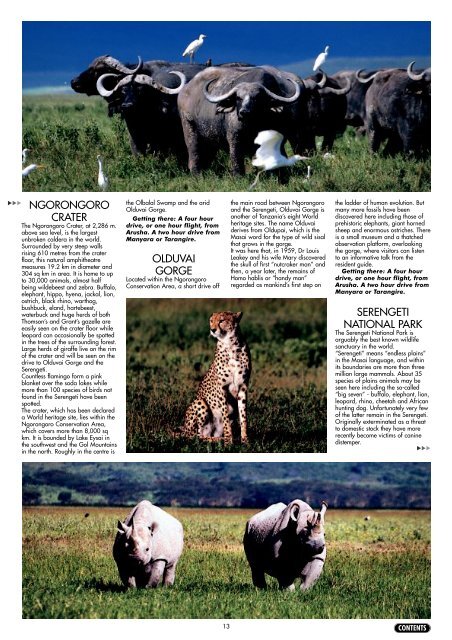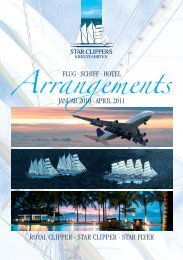TANZANIA PDF 2007
TANZANIA PDF 2007
TANZANIA PDF 2007
You also want an ePaper? Increase the reach of your titles
YUMPU automatically turns print PDFs into web optimized ePapers that Google loves.
���<br />
NGORONGORO<br />
CRATER<br />
The Ngorongoro Crater, at 2,286 m.<br />
above sea level, is the largest<br />
unbroken caldera in the world.<br />
Surrounded by very steep walls<br />
rising 610 metres from the crater<br />
floor, this natural amphitheatre<br />
measures 19.2 km in diameter and<br />
304 sq km in area. It is home to up<br />
to 30,000 animals, almost half<br />
being wildebeest and zebra. Buffalo,<br />
elephant, hippo, hyena, jackal, lion,<br />
ostrich, black rhino, warthog,<br />
bushbuck, eland, hartebeest,<br />
waterbuck and huge herds of both<br />
Thomson’s and Grant’s gazelle are<br />
easily seen on the crater floor while<br />
leopard can occasionally be spotted<br />
in the trees of the surrounding forest.<br />
Large herds of giraffe live on the rim<br />
of the crater and will be seen on the<br />
drive to Olduvai Gorge and the<br />
Serengeti.<br />
Countless flamingo form a pink<br />
blanket over the soda lakes while<br />
more than 100 species of birds not<br />
found in the Serengeti have been<br />
spotted.<br />
The crater, which has been declared<br />
a World heritage site, lies within the<br />
Ngorongoro Conservation Area,<br />
which covers more than 8,000 sq<br />
km. It is bounded by Lake Eysai in<br />
the southwest and the Gol Mountains<br />
in the north. Roughly in the centre is<br />
the Olbalal Swamp and the arid<br />
Olduvai Gorge.<br />
Getting there: A four hour<br />
drive, or one hour flight, from<br />
Arusha. A two hour drive from<br />
Manyara or Tarangire.<br />
OLDUVAI<br />
GORGE<br />
Located within the Ngorongoro<br />
Conservation Area, a short drive off<br />
the main road between Ngorongoro<br />
and the Serengeti, Olduvai Gorge is<br />
another of Tanzania’s eight World<br />
heritage sites. The name Olduvai<br />
derives from Oldupai, which is the<br />
Masai word for the type of wild sisal<br />
that grows in the gorge.<br />
It was here that, in 1959, Dr Louis<br />
Leakey and his wife Mary discovered<br />
the skull of first “nutcraker man” and<br />
then, a year later, the remains of<br />
Homo hablis or “handy man”<br />
regarded as mankind’s first step on<br />
the ladder of human evolution. But<br />
many more fossils have been<br />
discovered here including those of<br />
prehistoric elephants, giant horned<br />
sheep and enormous ostriches. There<br />
is a small museum and a thatched<br />
observation platform, overlooking<br />
the gorge, where visitors can listen<br />
to an informative talk from the<br />
resident guide.<br />
Getting there: A four hour<br />
drive, or one hour flight, from<br />
Arusha. A two hour drive from<br />
Manyara or Tarangire.<br />
SERENGETI<br />
NATIONAL PARK<br />
The Serengeti National Park is<br />
arguably the best known wildlife<br />
sanctuary in the world.<br />
“Serengeti” means “endless plains”<br />
in the Masai language, and within<br />
its boundaries are more than three<br />
million large mammals. About 35<br />
species of plains animals may be<br />
seen here including the so-called<br />
“big seven” - buffalo, elephant, lion,<br />
leopard, rhino, cheetah and African<br />
hunting dog. Unfortunately very few<br />
of the latter remain in the Serengeti.<br />
Originally exterminated as a threat<br />
to domestic stock they have more<br />
recently become victims of canine<br />
distemper.<br />
���<br />
13 CONTENTS







